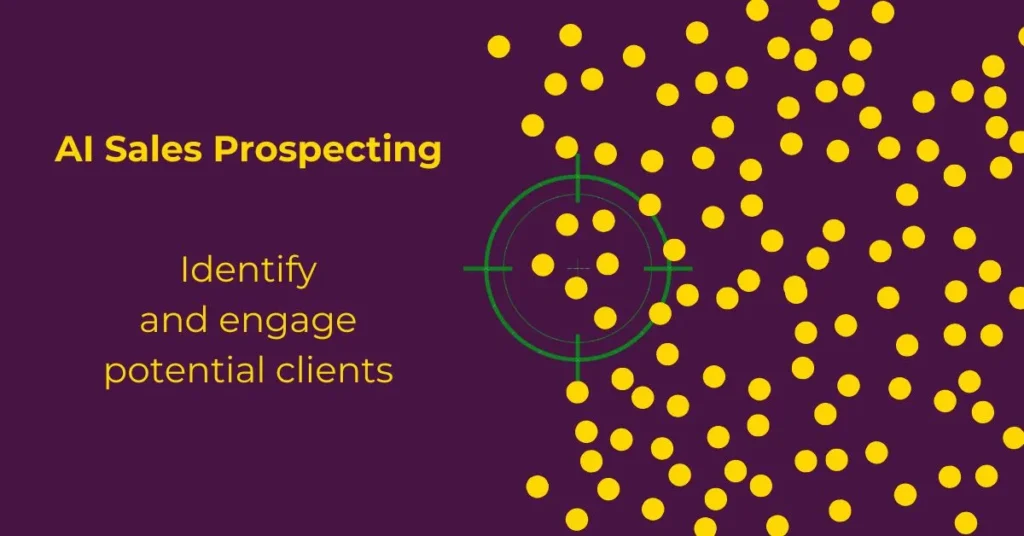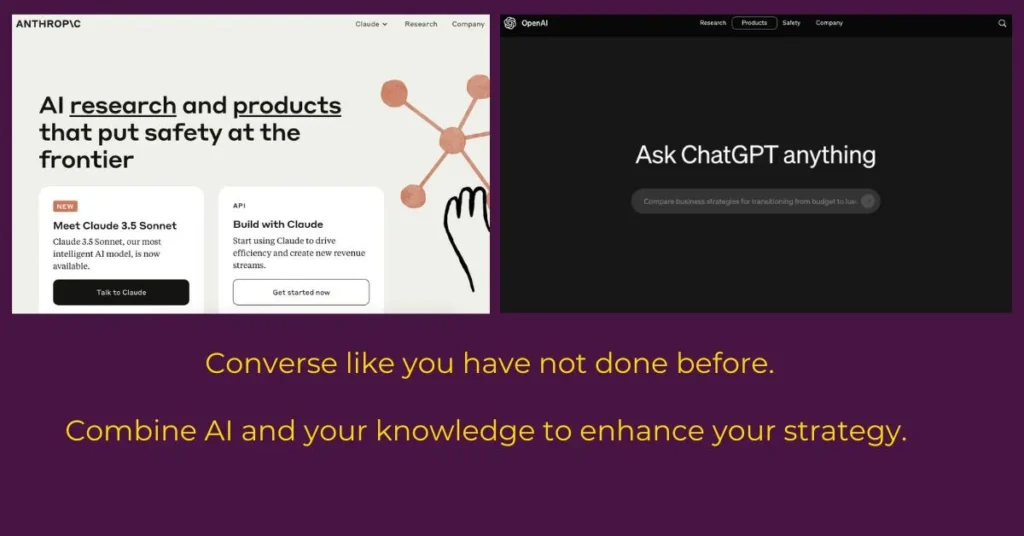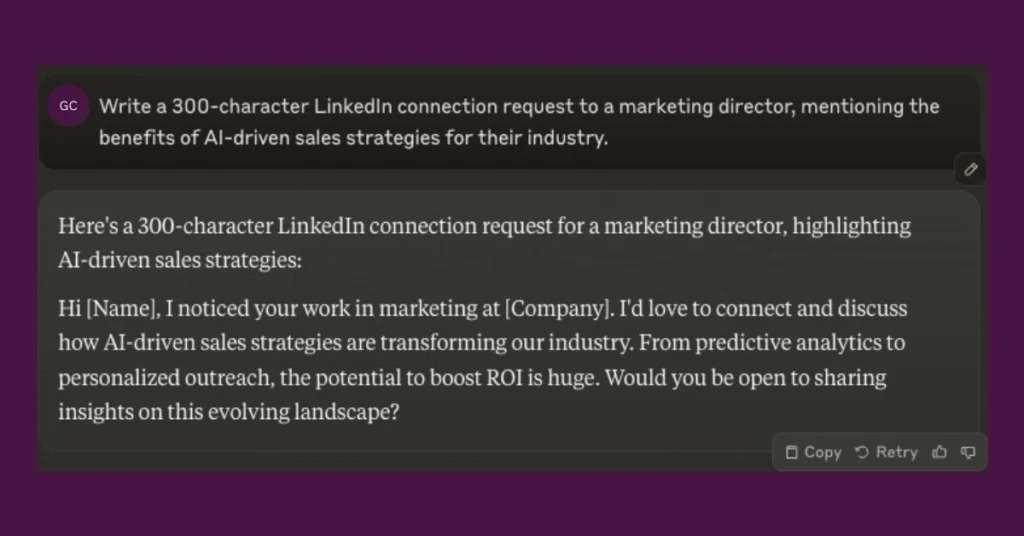AI Sales Prospecting: Leveraging LinkedIn for Lead Generation
In a word the B2B landscape is competitive. AI-driven sales prospecting is above all an opportunity to either become or maintain competiveness.
By and large the competitive nature of B2B has been furthered by high price rises and consumer demand. In various situations businesses have been purchased as investments, creating more Goliaths than Davids.
Regardless whether big, medium or small AI-driven sales prospecting is turning upside down how businesses can attract and engage potential clients.
In order to gain the opportunities learning and adapting is crucial. Thereafter you and your organisation can harness the power of AI to create compelling strategies that warm up prospects and drive organic lead generation.

The Power of AI in LinkedIn Strategy Development
Firstly, why LinkedIn? For this purpose of B2B prospecting LinkedIn is the social media of choice for businesses, buyers and senior leaders globally. And it sees 310 million users on the site each month.
Secondly and as noted in this article by dun & bradstreet 75% of B2B buyers and 84% of C-level executives use social media to aid purchasing decisions.
Therefore combining this shift in activity by B2B leaders alongside the significant progress in AI, it is an opportunity worth executing for sales organisations requiring growth.
Generally if you had wanted an effective LinkedIn presence you had to commit time and resource.
And yet those two elements come at a cost, particularly when email is still a stalwart in the playbook of many B2B marketing professionals the opportunity cost for some was too high.
Now it should no longer be a decision of how to reach prospects, whether via business development teams, email campaigns or tactical social media. As a result it should be an addition mindset, as I have said above we know these B2B leaders are on LinkedIn. So utilise AI-driven sales prospecting to increase your capabilities and engage with your buyers through another medium.

Benefits of AI-Enhanced LinkedIn Strategies for Sales Prospecting
Scalability: AI enables the production of large volumes of material quickly, because in reality time can be too scarce to produce content the ‘old school’ way. This allows you to significantly increase output and start maintaining an ever present (and consistent) LinkedIn presence.
Personalisation: One of AI’s fundamental features is the ability to sift through, analyse and draw multiple conclusions across large data sets from multiple sources. For this purpose the data is your prospect data.
AI tools for example Lusha and their engage AI feature colates data from LinkedIn and creates tailored approaches that grab attention. And importantly in the next stage of outreach Lusha personalises the outreach information to your prospect to maximise engagement.
Consistency: As I have said above consistency of content is benefitted. AI tools utilise features to maintain a memory about you and your business. Therefore when you use AI to co-create content it automatically can use what it knows. To ensure you have consistency of your brand voice and quality information across all posts and interactions.
Engagement Optimisation: B2B sales prospecting utilising AI and LinkedIn can be a 247 process covering many regions if not globally.
AI tools can suggest optimal posting times to find the balance of different regions and importantly when engagement is peaking on LinkedIn. Also you can use AI to get insight on which content types are favoured to maximise engagement on the platform.
Strategies for AI-Powered LinkedIn Prospecting
Unquestionably AI must be of interest to you if you have found this article and read this far. Depending on experience you will know and already use or alternatively be completely unfamiliar with AI prompts. It is important to realise that the prompt you give AI significantly impacts the output. For example bad in-bad out, great in-great out. So now we will dive into prompts you can use to engage with AI platforms whether that is Anthropic’s Claude or OpenAI’s ChatGPT.

1. Develop Tailored LinkedIn Profiles with AI Insights
Try to utilise AI generally for your companies page, but do not forget your own and any other key employee who will be personally prospecting and building industry credibility.
Instead of seeing your profile like any other social media profile, picture it like a shop window on a high street or a website. We can use AI to analyse successful profiles in your industry. For example, you might use prompts like:
“Based on top-performing sales profiles in the tech industry, suggest 5 key elements to include in a LinkedIn profile summary for a sales director at a B2B SaaS company.”
Remember simply change the industry whether that is for fashion, automotive, legal, finance or hospitality. And AI will adapt and assess what is correct information for you, enabling you to build an engaging and interesting LinkedIn profile page.
2. Generate Engaging LinkedIn Posts
Another way to leverage AI tools is to actually create content. This capability is what enables you to have a scaled output of content consistently.
To create thought-provoking posts, consider prompts such as:
“Create 5 LinkedIn post ideas about AI-driven sales strategies, each under 200 characters, that would engage B2B sales directors.”
Furthermore you could add phrases like “ask any appropriate questions before answering”, and AI will want to get detail on industry, product and potentially some of your features and benefits.

3. Craft Compelling LinkedIn Articles
Alongside LinkedIn post content, you can use AI to help draft longer-form material.
Draft being the key word, after all writing should contain your own experiences and inputs which AI hasn’t lived. And your industry knowledge will add nuance and provide a further depth of insight that your community will appreciate.
But to get started with a longer article, use a prompt like this:
“Outline a 1000-word LinkedIn article on ‘5 Ways AI is Transforming B2B Lead Generation’ with key statistics and actionable tips.”
Likewise with the prompt for LinkedIn posts you can again use the follow up phrase “ask any appropriate questions before answering”, to ensure AI captures the details about your businesses and its products and services.
As an example our blogs start life from identifying the appropriate topics and then jump into AI tools (currently Claude). Through prompts that helps us develop a structure through the different headings, and it provides some thoughts on copy as well. Then it is fully written and edited by human eye and mind to provide the knowledge and insight.
4. Develop Eye-Catching LinkedIn Visuals
You may have already come across AI art, however from our experience that is currently what it is.
With tools like OpenAI’s DALL:E it can create visuals following your prompts but sometimes they are rather Picasso’esque. So we find for B2B visuals such as infographics use AI for steering the concept and then use your normal insight to create and edit.
Therefore while AI can’t create images, it can help with ideas. Try:
“Suggest 3 infographic concepts that illustrate the benefits of AI-driven sales strategies for B2B companies.”
5. Personalise LinkedIn Connection Requests
I have certainly had it where I have finally found the appropriate person to reach out but then drawn a blank around my initial personalised message.
Even when you know the industry, your product and there business an initially prompt to get you started is needed.
Therefore use AI to craft personalised connection messages:
“Write a 300-character LinkedIn connection request to a marketing director, mentioning the benefits of AI-driven sales strategies for their industry.”

Overcoming Challenges of AI Sales Prospecting
While AI is very exciting in how it can help us to scale content, reach more prospects and grow businesses. It is important to be aware of it’s potential challenges.
Maintaining Authenticity: Although AI-generated material can be quick and easy to produce. Alongside it also being highly effective and informative. It is crucial to write your content from your personal experiences and knowledge. And it is important to re-write any AI content with your vocabuarly, phrases and industry key words. This will ensure what you create is consistent with your LinkedIn profile and your personal brand.
Ensuring Relevance: You are always learning in your industry. Changes in trends, updated regulations and also the ‘movers and shakers’. Remember as you interact with your preferred AI tool to keep that updated with these changes where relevant. As on the whole AI has its knowledge base from historical content and what is out there. Unfortunately it cannot predict the future and that does also include not knowing your future turnover! Regularly updating AI will mean all the content that AI co-creates with you will remain current and relevant.
Balancing AI and Human Input: In reality, especially with the current state of AI it is a tool to augment your capabilities, not replace them. For instance combine AI-generated ideas, strategies and visuals hand in hand with your own insights and experiences. Combined this will lead to the most impactful LinkedIn strategy.
Measuring the Impact of AI-Enhanced LinkedIn Strategies
As with most activity we have to gauge and access its value. Undoubtedly tracking social media can sometimes be subjective. But, to optimise your AI-driven efforts on LinkedIn, track objective key metrics such as:
- Engagement rates (likes, comments, shares) on your posts
- Growth in your LinkedIn network
- Inbound inquiries generated through your LinkedIn presence
- Conversion of LinkedIn connections to qualified leads
Regularly analyse these metrics in detail and don’t just obese over the quantity. Especially with engagement rates, are those who are engaging the right demographic and auidence. In effect analysing who they are can be more important than the quantity. As this limits the risk of praising a high engagement rate that is down to internal liking and sharing.
Additionally observe what content gets engaged with and causes growth in your network. Doing so allows you to refine your AI strategy and improve your results on LinkedIn. And we do also talk about continuous improvement from testing in our article Increasing B2B Sales.
Conclusion: Embracing LinkedIn for AI Sales Prospecting
AI-driven sales prospecting, particularly through LinkedIn, is transforming how B2B companies attract and engage potential clients. You too can leverage AI tools, you can create highly targeted, engaging strategies that warm up prospects and bring them to your sales team.
We believe that B2B companies can harness the power of AI for LinkedIn strategies and sales growth. As I have said above there are ways to optimise your LinkedIn page. And importantly generate engaging and consistent content that brings value to your network, community and industry. Ultimately we want you to be positioning you and your company as thought leaders in your industry.
Editorial process
Our articles are curated by experts in B2B business with expertise in AI. And are focused on the technological opportunities that exist for B2B businesses.
The reviews are constructed through the analysis of hundreds of actual experiences and condensed into our concise thumbs up or thumbs down format.
Some of the links in this article may be affiliate links. This means at no cost to you they may provide us compensation that helps fund the costs of this site.
Ashley James
With over a decade of B2B expertise across multiple industries and a passion for integrating new technology to elevate his ROI Ashley’s writing allows all of this to come together. His belief is many B2B businesses could maximise their time, focus and ROI to an even higher level.
Experiment with different messaging, content formats, and communication channels to determine what resonates most effectively with your target audience. Use A/B testing and data-driven insights to refine your approach and maximise results over time.
